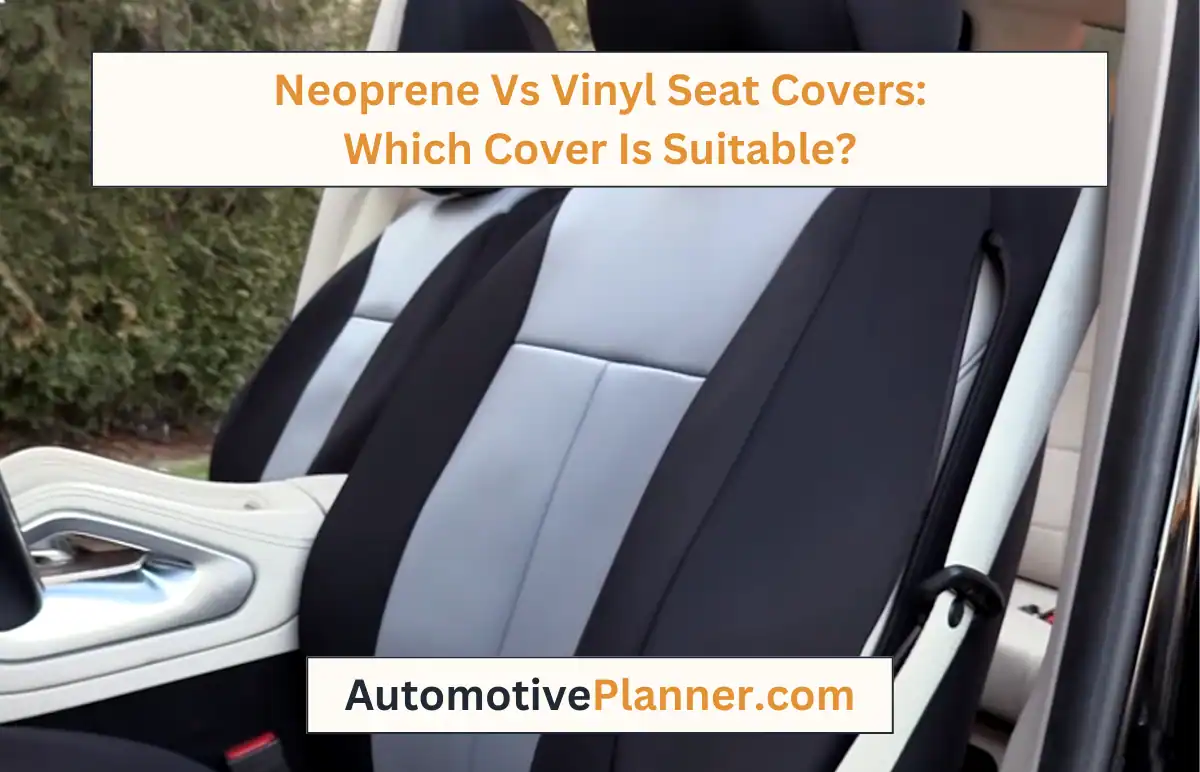Neoprene Vs Vinyl Seat Covers: Which Cover Is Suitable?
Choosing the right seat cover for your car involves an important decision between different materials, each offering unique benefits. Among the popular choices, neoprene vs vinyl seat covers stand out. Each has unique features that cater to specific needs and preferences.
Neoprene seat covers offer a soft, cushioned feel with natural elasticity for superior comfort. In contrast, vinyl seat covers feature a glossy finish, enhancing the car’s interior with a sleek and polished look. Also, there are other crucial differences.
In this article, the different characteristics between them are described. You will find a detailed discussion about these two seat covers. Read the article and find an easy solution between them to select a suitable cover for your car.
Comparison Table of Neoprene Vs Vinyl Seat Covers:
Compare neoprene and vinyl seat covers side by side to determine the option that best aligns with your preferences and needs.
| Category | Neoprene Seat Covers | Vinyl Seat Covers |
|---|---|---|
| Material Composition | Nearly 98% comes from rubber | Comes from high-grade Vinyl |
| Comfort And Texture | Soft and cushioned feel with natural elasticity | Generally firm texture, can be less forgiving |
| Water Resistance | Water resistant, but may not excel in extremes | Excellent resistance to water |
| Maintenance And Cleaning | Additional care may be required to prevent mold. | Easy maintenance and wipe-down due to smooth surface. |
| Breathability | Moderate breathability | Smooth surface promotes better airflow. |
| Price | Most Expensive | A few dollars to a few hundred dollars |
| Durability | Flexible and durable, suitable for heavy-duty use | Durable, but wear and tear can happen soon |
Feature Analytical Differences Between Neoprene Vs Vinyl Seat Covers:
Choosing the right seat cover is crucial when protecting and enhancing your car’s interior. Neoprene and vinyl seat covers are popular options with unique features and benefits. Here are five essential differences that set these materials apart.
1. Material Composition:
Made from synthetic rubber, neoprene seat covers offer flexibility, durability, and remarkable resistance to both water and UV rays. The material composition of neoprene ensures a combination of versatile performance and strong protection for the seats.
In contrast, vinyl seat covers are composed of polyvinyl chloride (PVC), offering a sleek finish. This distinction in material composition sets the foundation for their varied characteristics.
2. Comfort and Texture:
With a soft and cushioned feel, neoprene seat covers derive their comfort from the material’s natural elasticity, providing a snug fit for superior comfort during the drive. The inherent elasticity of neoprene contributes to a tailored and comfortable sitting experience.
Conversely, vinyl seat covers, although durable, can have a firm texture that can affect overall comfort. Vinyl’s durability can come at the cost of a potentially less forgiving and softer texture, affecting the tactile experience of occupants.
3. Water Resistance And Weather Performance:
Due to its inherent water resistance, neoprene excels in wet conditions and remains resilient in extreme weather conditions.
The water-resistant nature of neoprene makes it an excellent choice for challenging weather conditions, demonstrating adaptability and durability.
Despite the water resistance, vinyl seat covers cannot match the performance of neoprene in challenging weather conditions, which is important for various climates.
Neoprene’s superior performance in harsh weather conditions becomes a significant consideration in choosing between the two materials.
4. Aesthetics And Style:
Neoprene seat covers provide a sporty look with a customized fit, molding seamlessly to seat contours. The tailored design enhances the look, offering both style and a precise fit for the seats.
Conversely, vinyl seat covers feature a glossy finish, which adds a smooth and polished look that enhances the overall aesthetics of the vehicle. The glossy surface of the vinyl contributes to a refined and stylish look for the seats.
5. Maintenance And Cleaning:
Neoprene may require extra care to prevent mold or mildew growth, which influences the choice based on the preferred maintenance routine. Neoprene seat covers may require extra attention to maintenance to ensure they remain free of mold or mildew.
Vinyl seat covers, on the other hand, excel when it comes to maintenance, requiring only a straight wipe due to their smooth and non-porous surface. The ease of a simple wipe makes maintaining vinyl seats a convenient task.
6. Durability And Longevity:
Neoprene’s durability and flexibility increase its lifespan, especially under tough usage conditions. In unhealthy conditions, neoprene’s strong qualities increase longevity, ensuring reliable performance over time.
Although durable, vinyl seat covers can show signs of early wear and tear under certain conditions, prompting users to evaluate their longevity needs.
Evaluating longevity requirements becomes essential because vinyl seat covers may wear and tear earlier under certain conditions.
7. Breathability:
Providing a softer feel, unlike neoprene, vinyl may have limited breathability. The breathability of neoprene is relatively limited when compared to vinyl.
The smooth surface of vinyl promotes better airflow, enhancing breathability. Individuals prioritizing well-ventilated seating experiences may factor this into their decision-making.
8. Cost Considerations:
As a premium material, neoprene may entail a higher initial cost. The elevated initial cost is a characteristic of neoprene, reflecting its premium quality.
In contrast, vinyl seat covers provide a more budget-friendly option. Assessing budget constraints becomes pivotal for those seeking an optimal balance between quality and cost.
Related Questions:
Are Neoprene Seat Covers Good?
Neoprene seat covers for cars are generally considered suitable for several reasons. They are made from a synthetic rubber material known for its flexibility, durability, and resistance to water and UV rays. The natural elasticity of neoprene ensures a snug fit and comfortable sitting experience.
Moreover, its inherent water resistance makes it suitable for various climates. While they may require extra care to prevent mold or mildew, neoprene seat covers are a popular choice for those looking for comfort, durability, and protection for their car seats.
How Long Do Neoprene Seat Covers Last?
Neoprene seat covers typically last 10 years with proper care, but this can vary based on usage and quality. Regular cleaning and maintenance, avoiding harsh chemicals, and protection from excessive sun exposure can extend their lifespan.
Cheaper options may wear out sooner. Overall, expect around 3 to 5 years of use from high-quality neoprene seat covers.
Are Neoprene Seat Covers Hot In Summer?
Neoprene seat covers can get warm in hot summers. Although neoprene is not inherently hot, its insulating properties can trap heat between the cover and the seat. This can be a warm sensation for residents.
However, neoprene’s breathability is limited compared to other materials, and it cannot dissipate heat effectively in sweltering conditions.
Considering this, individuals in regions with intense summer heat can explore seat cover options with enhanced breathability for a more relaxed driving experience.
Final Verdict:
Neoprene provides a cushioned feel to the seat, along with water resistance. Its sporty looks and tailored fit enhance the aesthetic appeal of the car’s interior. On the other hand, vinyl seat covers are easy to maintain.
Many people prefer this seat cover as it is budget-friendly. Ultimately, neoprene vs vinyl seat covers which suit you, depending on comfort, weather resistance, style preferences, and budget constraints.








